Two Mechanism Pathways from a Versatile Arene Ruthenium Assembly: Reaching Aqueous Sensing Reversibility and Selectivity for CN−
Abstract
1. Introduction
2. Results
3. Materials and Methods
3.1. Materials
3.2. Instrumentation
3.3. Synthesis and Characterization of MRDPP
3.4. pKa Determination
3.5. DFT Calculations
3.6. General Spectroscopic Procedure
3.7. Detection Limit Determination
3.8. Calculation of Binding Constant (K)
3.9. Paper Strip Experiments
3.10. Regeneration of MRDPP
3.11. ATR-FTIR Measurement Procedure
4. Conclusions
Supplementary Materials
Author Contributions
Funding
Institutional Review Board Statement
Informed Consent Statement
Data Availability Statement
Acknowledgments
Conflicts of Interest
References
- Kruse, F.; Nguyen, A.D.; Dragelj, J.; Schlesinger, R.; Heberle, J.; Mroginski, M.A.; Weidinger, I.M. Characterisation of the Cyanate Inhibited State of Cytochrome c Oxidase. Sci. Rep. 2020, 10, 3863. [Google Scholar] [CrossRef]
- Shimada, A.; Baba, J.; Nagao, S.; Shinzawa-Itoh, K.; Yamashita, E.; Muramoto, K.; Tsukihara, T.; Yoshikawa, S. Crystallographic Cyanide-Probing for Cytochrome c Oxidase Reveals Structural Bases Suggesting that a Putative Proton Transfer H-Pathway Pumps Protons. J. Biol. Chem. 2023, 299, 105277. [Google Scholar] [CrossRef] [PubMed]
- Jaszczak-Wilke, E.; Polkowska, Ż.; Narkowicz, S.; Namieśnik, J. Cyanides in the Environment—Analysis—Problems and Challenges. Environ. Sci. Pollut. Res. 2017, 24, 15929–15948. [Google Scholar] [CrossRef]
- Oesterle, I.; Pretzler, M.; Rompel, A.; Warth, B. Comprehensive Polyphenolic Profiling of Nine Distinct Plants and Edible Mushrooms by Targeted and Untargeted LC-(HR)MS(/MS). Microchem. J. 2024, 200, 110358. [Google Scholar] [CrossRef]
- GB 5749-2006; Sanitary Standards for Drinking Water. National Standard of the People’s Republic of China: Beijing, China, 2006.
- World Health Organization. Guidelines for Drinking-Water Quality, 2nd ed.; World Health Organization: Geneva, Switzerland, 1996. [Google Scholar]
- Randviir, E.P.; Banks, C.E. The Latest Developments in Quantifying Cyanide and Hydrogen Cyanide. Trends Anal. Chem. 2015, 64, 75–85. [Google Scholar] [CrossRef]
- Wang, F.; Wang, L.; Chen, X.; Yoon, J. Recent Progress in the Development of Fluorometric and Colorimetric Chemosensors for Detection of Cyanide Ions. Chem. Soc. Rev. 2014, 43, 4312–4324. [Google Scholar] [CrossRef]
- Chakraborty, S.; Paul, S.; Roy, P.; Rayalu, S. Detection of Cyanide Ion by Chemosensing and Fluorosensing Technology. Inorg. Chem. Commun. 2021, 128, 108562. [Google Scholar] [CrossRef]
- Badugu, R.; Lakowicz, J.R.; Geddes, C.D. Cyanide-Sensitive Fluorescent Probes. Dyes Pigm. 2005, 64, 49–55. [Google Scholar] [CrossRef]
- Schepper, J.; Orthaber, A.; Pammer, F. Tetrazole-Functionalized Organoboranes Exhibiting Dynamic Intramolecular N→B-Coordination and Cyanide-Selective Anion Binding. Chem. Eur. J. 2024, 30, e202401466. [Google Scholar] [CrossRef]
- Lin, Y.-S.; Zheng, J.-X.; Tsui, Y.-K.; Yen, Y.-P. Colorimetric Detection of Cyanide with Phenyl Thiourea Derivatives. Spectrochim. Acta, Part A Mol. Biomol. Spectrosc. 2011, 79, 1552–1558. [Google Scholar] [CrossRef]
- Kumar, A.; Kim, H.-S. A Pyrenesulfonyl-Imidazolium Derivative as a Selective Cyanide Ion Sensor in Aqueous Media. New J. Chem. 2015, 39, 2935–2942. [Google Scholar] [CrossRef]
- Tomasulo, M.; Raymo, F.M. Colorimetric Detection of Cyanide with a Chromogenic Oxazine. Org. Lett. 2005, 7, 4633–4636. [Google Scholar] [CrossRef] [PubMed]
- Chahal, M.K.; Sankar, M. Porphyrin Chemodosimeters: Synthesis, Electrochemical Redox Properties and Selective ‘Naked-Eye’ Detection of Cyanide Ions. RSC Adv. 2015, 5, 99028–99036. [Google Scholar] [CrossRef]
- Lee, C.H.; Yoon, H.J.; Shim, J.S.; Jang, W.D. A Boradiazaindacene-Based Turn-On Fluorescent Probe for Cyanide Detection in Aqueous Media. Chem. Eur. J. 2012, 18, 4513–4516. [Google Scholar] [CrossRef]
- Mahato, D.; Fajal, S.; Samanta, P.; Mandal, W.; Ghosh, S.K. Selective and Sensitive Fluorescence Turn-On Detection of Cyanide Ions in Water by Post Metallization of a MOF. ChemPlusChem 2022, 87, e202100426. [Google Scholar] [CrossRef] [PubMed]
- Chow, C.-F.; Ho, P.-Y.; Wong, W.-L.; Gong, C.-B. A Multifunctional Bimetallic Molecular Device for Ultrasensitive Detection, Naked-Eye Recognition, and Elimination of Cyanide Ions. Chem. Eur. J. 2015, 21, 12984–12990. [Google Scholar] [CrossRef]
- Fernandes, G.E.; Chang, Y.-W.; Sharma, A.; Tutt, S. One-Step Assembly of Fluorescence-Based Cyanide Sensors from Inexpensive, Off-The-Shelf Materials. Sensors 2020, 20, 4488. [Google Scholar] [CrossRef]
- Rajamanikandan, R.; Sasikumar, K.; Kosame, S.; Ju, H. Optical Sensing of Toxic Cyanide Anions Using Noble Metal Nanomaterials. Nanomaterials 2023, 13, 290. [Google Scholar] [CrossRef]
- Goswami, S.; Manna, A.; Paul, S.; Das, A.K.; Aich, K.; Nandi, P.K. Resonance-Assisted Hydrogen Bonding Induced Nucleophilic Addition to Hamper ESIPT: Ratiometric Detection of Cyanide in Aqueous Media. Chem. Commun. 2013, 49, 2912–2914. [Google Scholar] [CrossRef]
- Padghan, S.D.; Wang, L.-C.; Lin, W.-C.; Hu, J.-W.; Liu, W.-C.; Chen, K.-Y. Rational Design of an ICT-Based Chemodosimeter with Aggregation-Induced Emission for Colorimetric and Ratiometric Fluorescent Detection of Cyanide in a Wide pH Range. ACS Omega 2021, 6, 5287–5296. [Google Scholar] [CrossRef]
- Hua, Y.-X.; Shao, Y.; Wang, Y.-W.; Peng, Y. A Series of Fluorescent and Colorimetric Chemodosimeters for Selective Recognition of Cyanide Based on the FRET Mechanism. J. Org. Chem. 2017, 82, 6259–6267. [Google Scholar] [CrossRef]
- Mandal, M.; Banik, D.; Karak, A.; Manna, S.K.; Mahapatra, A.K. Spiropyran–Merocyanine Based Photochromic Fluorescent Probes: Design, Synthesis, and Applications. ACS Omega 2022, 7, 36988–37007. [Google Scholar] [CrossRef]
- Jung, H.S.; Han, J.H.; Kim, Z.H.; Kang, C.; Kim, J.S. Coumarin-Cu(II) Ensemble-Based Cyanide Sensing Chemodosimeter. Org. Lett. 2011, 13, 5056–5059. [Google Scholar] [CrossRef]
- Liang, C.; Jiang, S. Fluorescence Light-Up Detection of Cyanide in Water Based on Cyclization Reaction Followed by ESIPT and AIEE. Analyst 2017, 142, 4825–4833. [Google Scholar] [CrossRef]
- Nazarian, R.; Darabi, H.R.; Aghapoor, K.; Firouzi, R.; Sayahi, H. A Highly Sensitive “ON–OFF” Optical Sensor for the Selective Detection of Cyanide Ions in 100% Aqueous Solutions Based on Hydrogen Bonding and Water Assisted Aggregation Induced Emission. Chem. Commun. 2020, 56, 8992–8995. [Google Scholar] [CrossRef]
- Wei, T.-B.; Ding, J.-D.; Chen, J.-F.; Han, B.-B.; Jiang, X.-M.; Yao, H.; Zhang, Y.-M.; Lin, Q. A Cyanide-Triggered Hydrogen-Bond-Breaking Deprotonation Mechanism: Fluorescent Detection of Cyanide Using a Thioacetohydrazone-Functionalized Bispillar [5]arene. New J. Chem. 2018, 42, 1271–1275. [Google Scholar] [CrossRef]
- Wei, T.-B.; Li, W.-T.; Li, Q.; Su, J.-X.; Qu, W.-J.; Lin, Q.; Yao, H.; Zhang, Y.-M. A Turn-On Fluorescent Chemosensor Selectively Detects Cyanide in Pure Water and Food Sample. Tetrahedron Lett. 2016, 57, 2767–2771. [Google Scholar] [CrossRef]
- Ma, J.; Dasgupta, P.K. Recent Developments in Cyanide Detection: A Review. Anal. Chim. Acta 2010, 673, 117–125. [Google Scholar] [CrossRef]
- Rashid, A.; Mondal, S.; Ghosh, P. Development and Application of Ruthenium(II) and Iridium(III) Based Complexes for Anion Sensing. Molecules 2023, 28, 1231. [Google Scholar] [CrossRef] [PubMed]
- Kumar, S.; Singh, S.; Kumar, A.; Murthy, K.S.R.; Singh, A.K. pH-Responsive Luminescence Sensing, Photoredox Catalysis and Photodynamic Applications of Ruthenium(II) Photosensitizers Bearing Imidazo[4,5-f][1,10]phenanthroline Scaffolds. Coord. Chem. Rev. 2022, 452, 214272. [Google Scholar] [CrossRef]
- Therrien, B. Ruthenium-Based Sensors. Inorganics 2024, 12, 239. [Google Scholar] [CrossRef]
- Li, M.-J.; Lin, Z.; Chen, X.; Chen, G. Colorimetric and Luminescent Bifunctional Ru(II) Complexes for Rapid and Highly Sensitive Recognition of Cyanide. Dalton Trans. 2014, 43, 11745–11751. [Google Scholar] [CrossRef]
- Zhu, J.-W.; Ou, H.-D.; Xu, N.; Deng, W.; Yao, Z.-J. Ruthenium-Based Phosphorescent Probe for Selective and Naked-Eye Detection of Cyanide in Aqueous Media. Dyes Pigm. 2020, 176, 108196. [Google Scholar] [CrossRef]
- Mardanya, S.; Karmakar, S.; Bar, M.; Baitalik, S. Pyrene-Biimidazole Based Ru(II) and Os(II) Complexes as Highly Efficient Probes for the Visible and Near-Infrared Detection of Cyanide in Aqueous Media. Dalton Trans. 2015, 44, 21053–21072. [Google Scholar] [CrossRef]
- Alreja, P.; Kaur, N. Establishing the anion recognition correlation of the 2-(2-methoxyphenyl)-1H-imidazo [4, 5-f][1,10] phenanthroline and its Ru(bipy)22+ complex via fluorimetry. J. Lumin. 2016, 179, 372–377. [Google Scholar] [CrossRef]
- Pal, P.; Ganguly, T.; Karmakar, S.; Baitalik, S. Anion- and solvent induced modulation of photophysical properties of a luminescent bimetallic Ru(II) complex: Experimental and TD-DFT study. Inorg. Chim. Acta 2020, 502, 119337. [Google Scholar] [CrossRef]
- Bar, M.; Maity, D.; Das, K.; Baitalik, S. Asymmetric Bimetallic Ruthenium(II) Complexes Selectively Sense Cyanide in Water through Significant Modulation of Their Ground and Excited State Properties. Sens. Actuators B 2017, 251, 208–223. [Google Scholar] [CrossRef]
- Zavalishin, M.N.; Guschin, A.A.; Nikitin, G.A.; Gamov, G.A. Two Isoniazid-Based Chemosensors for the Detection of Cyanide Ions in Solution: An Experimental and Computational Study. Photochem. Photobiol. Sci. 2025, 24, 53–63. [Google Scholar] [CrossRef] [PubMed]
- Barkale, H.V.; Dey, N. Selective Sensing of Cyanide Ions: Impact of Molecular Design and Assembly on the Response of π-Conjugated Acylhydrazone Compounds. RSC Adv. 2024, 14, 25108–25114. [Google Scholar] [CrossRef]
- Gaumerd, V.; Capello, Y.; Bonnin, Q.; Renard, P.-Y.; Romieu, A. Fluorogenic Detection of Cyanide Ions in Pure Aqueous Media through an Intramolecular Crossed-Benzoin Reaction: Limitations Unveiled and Possible Solutions. Analyst 2025, 150, 168–176. [Google Scholar] [CrossRef]
- Zhao, J.; Zhou, Z.; Li, G.; Stang, P.J.; Yan, X. Light-Emitting Self-Assembled Metallacages. Natl. Sci. Rev. 2021, 8, nwab045. [Google Scholar] [CrossRef]
- Yin, C.; Du, J.; Olenyuk, B.; Stang, P.J.; Sun, Y. The Applications of Metallacycles and Metallacages. Inorganics 2023, 11, 54. [Google Scholar] [CrossRef]
- Tang, J.-H.; Zhong, Y.-W. Anthracene-Containing Metallacycles and Metallacages: Structures, Properties, and Applications. Inorganics 2022, 10, 88. [Google Scholar] [CrossRef]
- Li, Y.; Zhang, J.; Li, H.; Fan, Y.; He, T.; Qiu, H.; Yin, S. Metallacycle/Metallacage-Cored Fluorescent Supramolecular Assemblies with Aggregation-Induced Emission Properties. Adv. Opt. Mater. 2020, 8, 1902190. [Google Scholar] [CrossRef]
- Ludden, M.D.; Ward, M.D. Outside the Box: Quantifying Interactions of Anions with the Exterior Surface of a Cationic Coordination Cage. Dalton Trans. 2021, 50, 2782–2791. [Google Scholar] [CrossRef]
- Yadav, S.; Kannan, P.; Qiu, G. Cavity-Based Applications of Metallo-Supramolecular Coordination Cages (MSCCs). Org. Chem. Front. 2020, 7, 2842–2872. [Google Scholar] [CrossRef]
- Zhang, L.; Liu, H.; Yuan, G.; Han, Y.-F. Chiral Coordination Metallacycles/Metallacages for Enantioselective Recognition and Separation. Chin. J. Chem. 2021, 39, 2273–2286. [Google Scholar] [CrossRef]
- Vardhan, H.; Mehta, A.; Ezugwu, C.I.; Verpoort, F. Self-Assembled Arene Ruthenium Metalla-Assemblies. Polyhedron 2016, 112, 104–108. [Google Scholar] [CrossRef]
- Barry, N.P.E.; Therrien, B. Host–Guest Chemistry in the Hexanuclear (Arene)ruthenium Metalla-Prismatic Cage [Ru6(p-cymene)6(tpt)2(dhnq)3]6+. Eur. J. Inorg. Chem. 2009, 2009, 4695–4700. [Google Scholar] [CrossRef]
- Dhara, S.; Ansari, M.A.; Lahiri, G.K. Host–Guest Feature of DPPP Bridged Arene–Ruthenium Clip Derived Molecular Rectangle. Inorg. Chem. 2019, 58, 10991–10999. [Google Scholar] [CrossRef]
- Maatouk, A.; Rossel, T.; Therrien, B. Allosteric Fluorescent Detection of Saccharides and Biomolecules in Water from a Boronic Acid Functionalized Arene Ruthenium Assembly Hosting Fluorescent Dyes. Inorganics 2025, 13, 1. [Google Scholar] [CrossRef]
- Grzybowski, M.; Gryko, D.T. Diketopyrrolopyrroles: Synthesis, Reactivity, and Optical Properties. Adv. Opt. Mater. 2015, 3, 280–320. [Google Scholar] [CrossRef]
- Mishra, A.; Kang, S.C.; Chi, K.-W. Coordination-Driven Self-Assembly of Arene–Ruthenium Compounds. Eur. J. Inorg. Chem. 2013, 2013, 5222–5232. [Google Scholar] [CrossRef]
- Barare, B.; Babahan, I.; Hijji, Y.M.; Bonyi, E.; Tadesse, S.; Aslan, K. A Highly Selective Sensor for Cyanide in Organic Media and on Solid Surfaces. Sensors 2016, 16, 271. [Google Scholar] [CrossRef]
- Bíró, L.; Hüse, D.; Bényei, A.C.; Buglyó, P. Interaction of [Ru(η6-p-cym)(H2O)3]2+ with Citrate and Tricarballate Ions in Aqueous Solution; X-ray Crystal Structure of Novel Half-Sandwich Ru(II)-Citrato Complexes. J. Inorg. Biochem. 2012, 116, 116–125. [Google Scholar] [CrossRef]
- Mizuguchi, J.; Wooden, G. A Large Bathochromic Shift from the Solution to the Solid State in 1,4-Diketo-3,6-Diphenyl-Pyrrolo[3,4-c]pyrrole. Ber. Bunsenges. Phys. Chem. 1991, 95, 1264–1274. [Google Scholar] [CrossRef]
- Mataga, N.; Kubota, T. Molecular Interactions and Electronic Spectra; Marcel Dekker: New York, NY, USA, 1970. [Google Scholar]
- Borah, J.; Hazarika, U.N.; Khakhlary, P. Extending the Chemistry of Reaction between BODIPY and Cyanide Ions: An Application in Selective Sensing of Fluoride and Cyanide Ions. ACS Omega 2022, 7, 46234–46240. [Google Scholar] [CrossRef]
- Ho, J.; Coote, M.L. A universal approach for continuum solvent pKa calculations: Are we there yet? Theor. Chem. Acc. 2010, 125, 3–21. [Google Scholar] [CrossRef]
- ChemAxon Software. Calculators Playground, v.1.6.2. ChemAxon. Available online: http://www.chemaxon.com (accessed on 25 September 2025).
- Adamo, C.; Scuseria, G.E.; Barone, V. Accurate excitation energies from time-dependent density functional theory: Assessing the PBE0 model. J. Chem. Phys. 1999, 111, 2889–2899. [Google Scholar] [CrossRef]
- Palakkeezhillam, V.N.V.; Haribabu, J.; Kumar, V.S.; Santibanez, J.F.; Manakkadan, V.; Rasin, P.; Garg, M.; Bhuvanesh, N.; Sreekanth, A. Unraveling the anticancer efficacy and biomolecular properties of Ru(II)-arene complexes of pyrene-based thiosemicarbazone ligands: A comprehensive In silico/In vitro exploration. Organometallics 2024, 43, 242–260. [Google Scholar] [CrossRef]
- Abirami, A.; Devan, U.; Ramesh, R.; Velanganni, A.A.J.; Małecki. Naphthoyl benzhydrazine–decorated binuclear arene Ru(II) complexes as anticancer agents targeting human breast cancer cells. Dalton Trans. 2023, 52, 16376–16387. [Google Scholar] [CrossRef]
- Fonseca Guerra, C.; Handgraaf, J.W.; Baerends, E.J.; Bickelhaupt, F.M. Voronoi Deformation Density (VDD) Charges: Assessment of the Mulliken, Bader, Hirshfeld, Weinhold, and VDD Methods for Charge Analysis. J. Comput. Chem. 2004, 25, 189–210. [Google Scholar] [CrossRef]
- Hirshfeld, F.L. Bonded-Atom Fragments for Describing Molecular Charge Densities. Theor. Chim. Acta 1977, 44, 129–138. [Google Scholar] [CrossRef]
- Li, G.; Tao, F.; Wang, H.; Wang, L.; Zhang, J.; Ge, P.; Liu, L.; Tong, Y.; Sun, S. A Novel Reversible Colorimetric Chemosensor for the Detection of Cu2+ Based on a Water-Soluble Polymer Containing Rhodamine Receptor Pendants. RSC Adv. 2015, 5, 18983–18989. [Google Scholar] [CrossRef]
- Shiraishi, Y.; Yamamoto, K.; Sumiya, S.; Hirai, T. Spiropyran as a Reusable Chemosensor for Selective Colorimetric Detection of Aromatic Thiols. Phys. Chem. Chem. Phys. 2014, 16, 12137–12142. [Google Scholar] [CrossRef]
- DeGroot, H.P.; Hanusa, T.P. Cyanide Complexes of the Transition Metals. In Encyclopedia of Inorganic and Bioinorganic Chemistry; King, R.B., Ed.; Wiley: Chichester, UK, 2020. [Google Scholar]
- Beck, M.T. Critical Survey of Stability Constants of Cyano Complexes. Pure Appl. Chem. 1987, 59, 1703–1720. [Google Scholar] [CrossRef]
- Gholami, M.D.; Liu, Q.; Sonar, P.; Manzhos, S.; Ayoko, G.A.; Izake, E.L. Naphthalene flanked diketopyrrolopyrrole: A new functional dye based optical sensors for monitoring cyanide ions in water. Adv. Mater. Technol. 2022, 7, 2100170. [Google Scholar] [CrossRef]
- Lv, X.; Liu, J.; Liu, Y.L.; Zhao, Y.; Chen, M.; Wang, P.; Guo, W. Rhodafluor-Based Chromo- and Fluorogenic Probe for Cyanide Anion. Sens. Actuators B Chem. 2011, 158, 405–410. [Google Scholar] [CrossRef]
- Garci, A.; Dobrov, A.A.; Riedel, T.; Orhan, E.; Dyson, P.J.; Arion, V.B.; Therrien, B. Strategy to Optimize the Biological Activity of Arene Ruthenium Metalla-Assemblies. Organometallics 2014, 33, 3813–3822. [Google Scholar] [CrossRef]
- Jenni, S.; Ponsot, F.; Baroux, P.; Collard, L.; Ikeno, T.; Hanaoka, K.; Quesneau, V.; Renault, K.; Romieu, A. Design, Synthesis and Evaluation of Enzyme-Responsive Fluorogenic Probes Based on Pyridine-Flanked Diketopyrrolopyrrole Dyes. Spectrochim. Acta Part A 2021, 248, 119179. [Google Scholar] [CrossRef]
- Romero, R.; Salgado, P.R.; Soto, C.; Contreras, D.; Melin, V. An Experimental Validated Computational Method for pKa Determination of Substituted 1,2-Dihydroxybenzenes. Front. Chem. 2018, 6, 208. [Google Scholar] [CrossRef]
- Salgado, L.E.V.; Vargas-Hernández, C. Spectrophotometric Determination of the pKₐ, Isosbestic Point, and Equation of Absorbance vs. pH for a Universal pH Indicator. Am. J. Anal. Chem. 2014, 5, 1290–1301. [Google Scholar] [CrossRef]
- Czyrski, A. The Spectrophotometric Determination of Lipophilicity and Dissociation Constants of Ciprofloxacin and Levofloxacin. Spectrochim. Acta A Mol. Biomol. Spectrosc. 2022, 265, 120343. [Google Scholar] [CrossRef]
- Gran, G. Determination of the Equivalence Point in Potentiometric Titrations. Acta Chem. Scand. 1950, 4, 559–577. [Google Scholar] [CrossRef]
- Te Velde, G.; Bickelhaupt, F.M.; Baerends, E.J.; Fonseca Guerra, C.; van Gisbergen, S.J.A.; Snijders, J.G.; Ziegler, T. Chemistry with ADF. J. Comp. Chem. 2021, 22, 931. [Google Scholar] [CrossRef]
- Fonseca Guerra, C.; Snijders, J.G.; te Velde, G.; Baerends, E.J. Towards an order-N DFT method. Theor. Chem. Acc. 1998, 99, 391. [Google Scholar] [CrossRef]
- Baerends, E.J.; Ziegler, T.; Autschbach, J.; Bashford, D.; Bérces, A.; Bickelhaupt, F.M.; Bo, C.; Boerrigter, P.M.; Cavallo, L.; Chong, D.P.; et al. ADF2014, SCM, Theoretical Chemistry, Vrije Universiteit, Amsterdam, The Netherlands. Available online: https://www.scm.com/amsterdam-modeling-suite/adf/ (accessed on 25 September 2025).
- Chong, D.P. Augmenting basis set for time-dependent density functional theory calculation of excitation energies: Slater-type orbitals for hydrogen to krypton. Mol. Phys. 2005, 103, 749. [Google Scholar] [CrossRef]
- Klamt, A.; Schürmann, G.J. COSMO: A new approach to dielectric screening in solvents with explicit expressions for the screening energy and its gradient. J. Chem. Soc. Perkin Trans. 1993, 2, 799. [Google Scholar] [CrossRef]
- Klamt, A.; Jonas, V. Treatment of the outlying charge in continuum solvation models. J. Chem. Phys. 1996, 105, 9972. [Google Scholar] [CrossRef]
- Pye, C.C.; Ziegler, T. An implementation of the conductor-like screening model of solvation within the Amsterdam density functional package. Theor. Chem. Acc. 1999, 101, 396. [Google Scholar] [CrossRef]
- Microsoft Corporation. Microsoft Excel, Version 2016; Microsoft Corporation: Redmond, WA, USA, 2016. [Google Scholar]
- GraphPad Software. GraphPad Prism, Version 5.0; GraphPad Software Inc.: San Diego, CA, USA, 2008.
- Analytical Methods Committee. Recommendations for the Definition, Estimation and Use of the Detection Limit. Analyst 1987, 112, 199–204. [Google Scholar] [CrossRef]
- Schneider, H.-J.; Yatsimirsky, A. Principles and Methods in Supramolecular Chemistry; John Wiley & Sons: Chichester, UK, 2000; p. 142. [Google Scholar]
- Rumble, J.R. (Ed.) CRC Handbook of Chemistry and Physics, 105th ed.; CRC Press: Boca Raton, FL, USA, 2024. [Google Scholar]

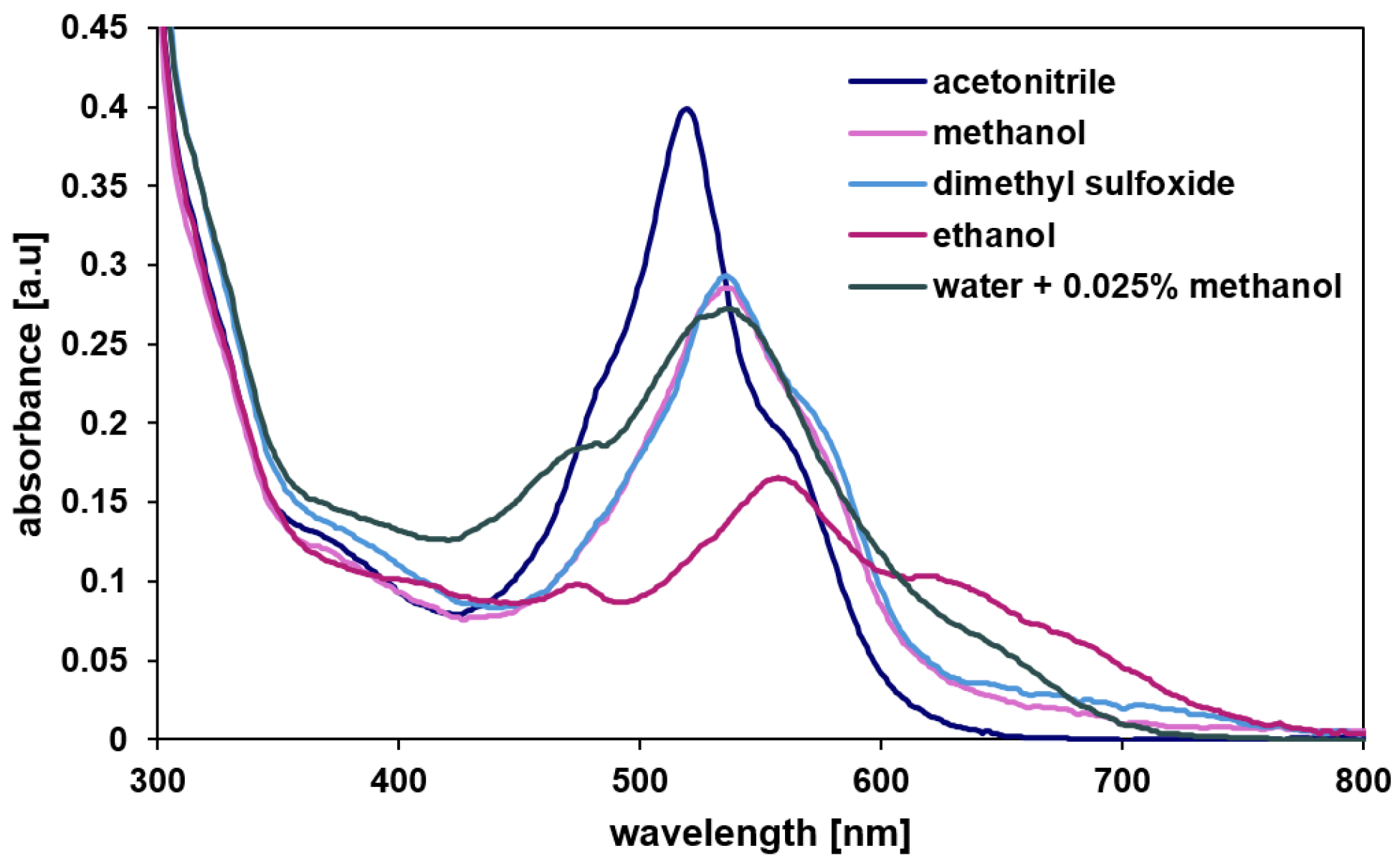
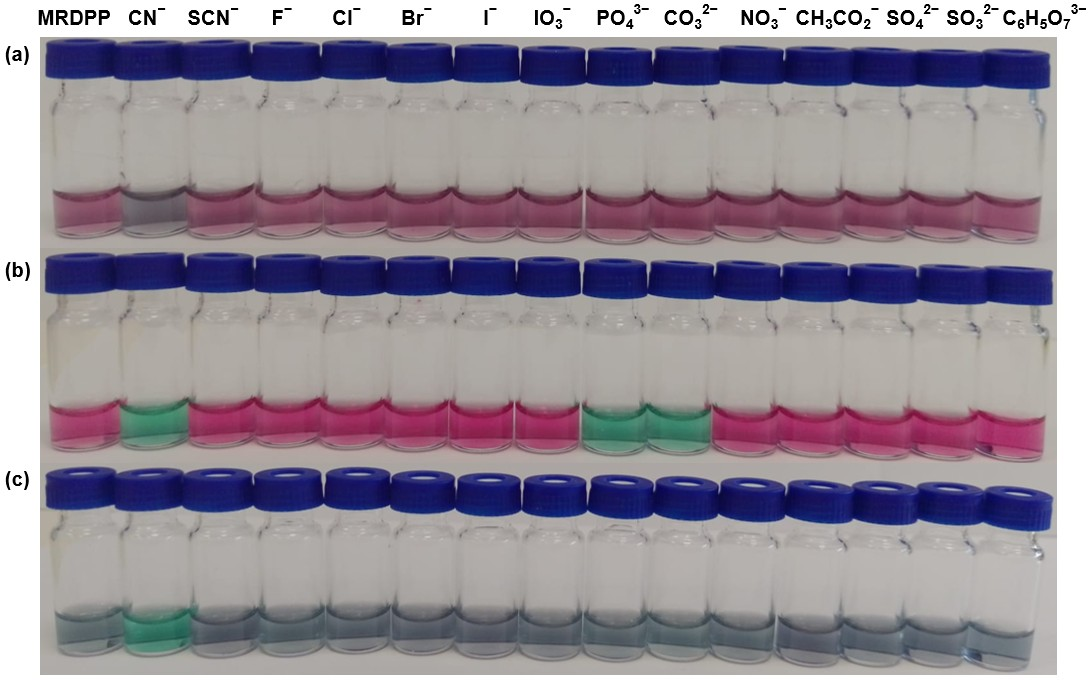
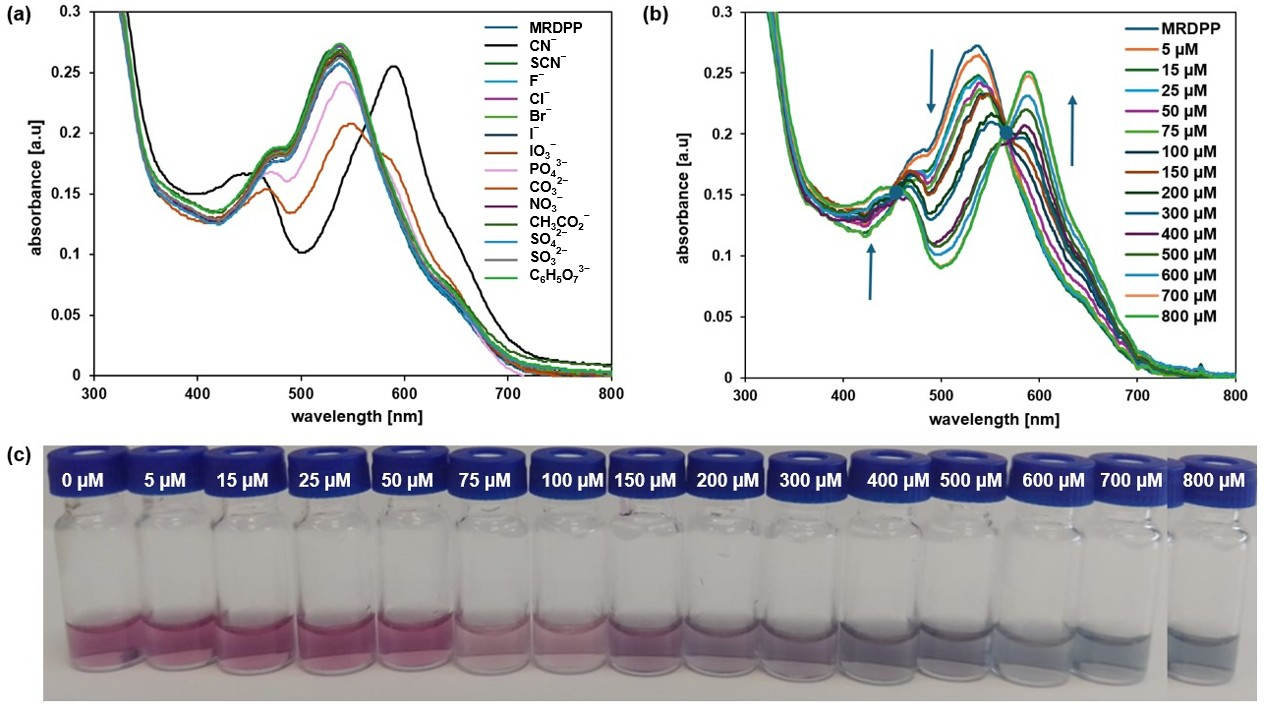
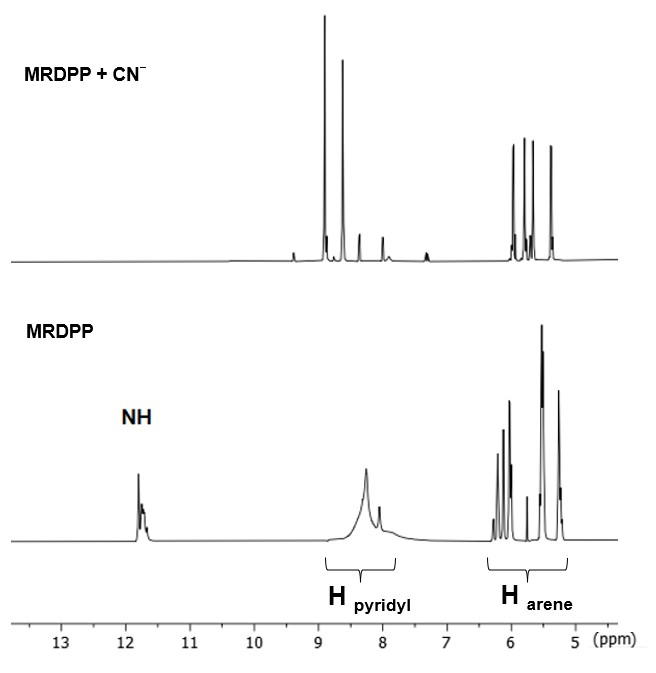
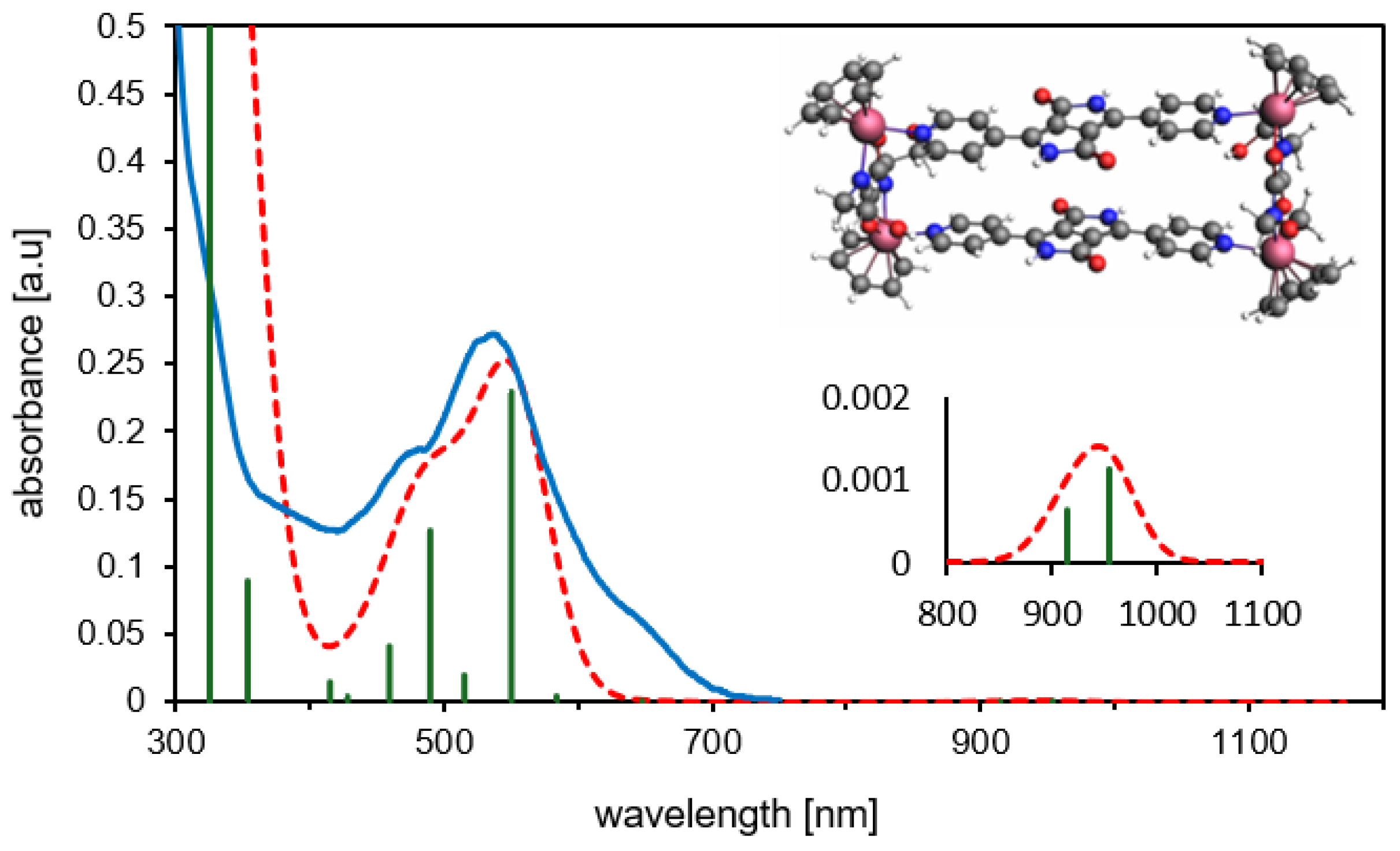
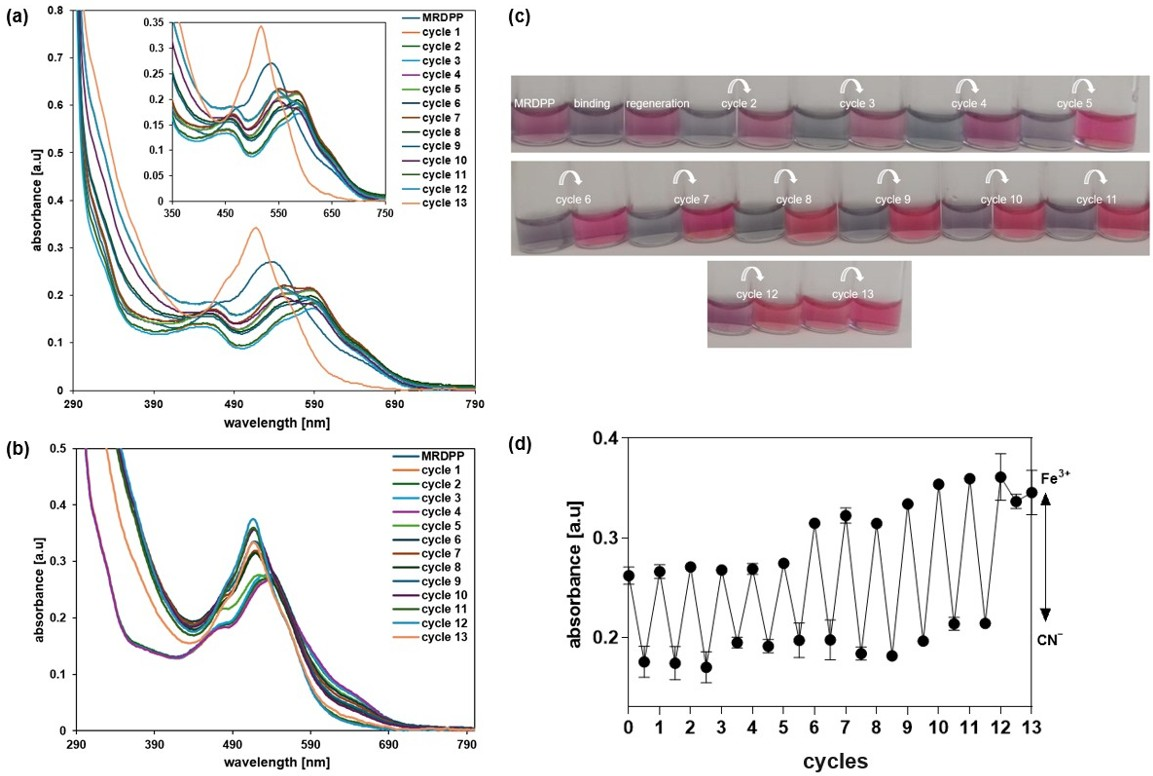

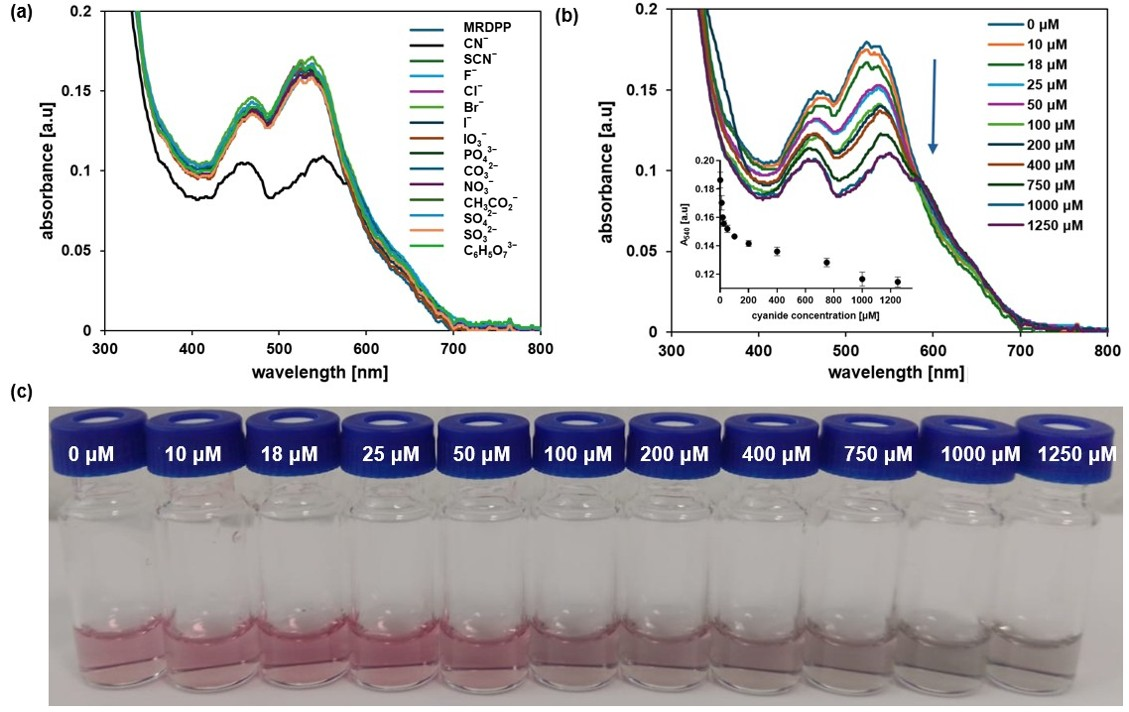
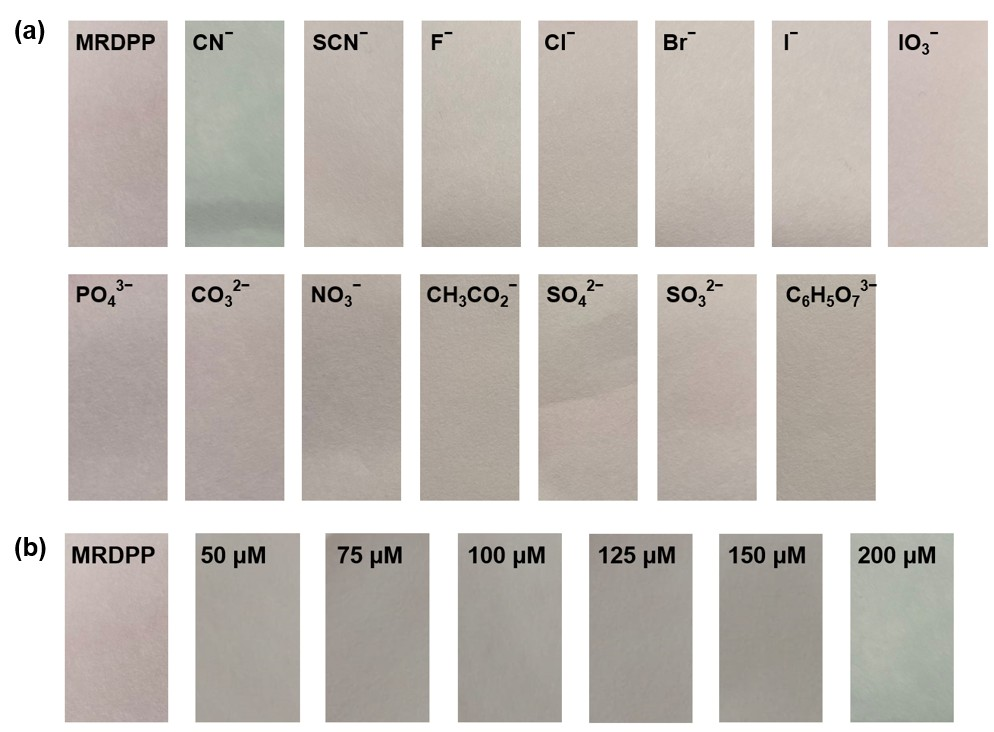

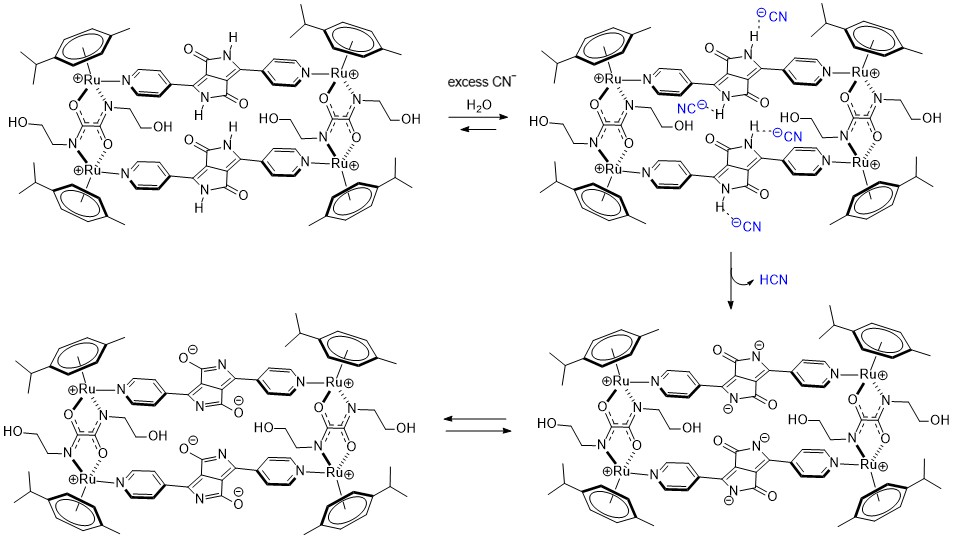

Disclaimer/Publisher’s Note: The statements, opinions and data contained in all publications are solely those of the individual author(s) and contributor(s) and not of MDPI and/or the editor(s). MDPI and/or the editor(s) disclaim responsibility for any injury to people or property resulting from any ideas, methods, instructions or products referred to in the content. |
© 2025 by the authors. Licensee MDPI, Basel, Switzerland. This article is an open access article distributed under the terms and conditions of the Creative Commons Attribution (CC BY) license (https://creativecommons.org/licenses/by/4.0/).
Share and Cite
Maatouk, A.; Rossel, T.; Colombo, G.; Brenna, S.; Therrien, B. Two Mechanism Pathways from a Versatile Arene Ruthenium Assembly: Reaching Aqueous Sensing Reversibility and Selectivity for CN−. Inorganics 2025, 13, 357. https://doi.org/10.3390/inorganics13110357
Maatouk A, Rossel T, Colombo G, Brenna S, Therrien B. Two Mechanism Pathways from a Versatile Arene Ruthenium Assembly: Reaching Aqueous Sensing Reversibility and Selectivity for CN−. Inorganics. 2025; 13(11):357. https://doi.org/10.3390/inorganics13110357
Chicago/Turabian StyleMaatouk, Alaa, Thibaud Rossel, Gioele Colombo, Stefano Brenna, and Bruno Therrien. 2025. "Two Mechanism Pathways from a Versatile Arene Ruthenium Assembly: Reaching Aqueous Sensing Reversibility and Selectivity for CN−" Inorganics 13, no. 11: 357. https://doi.org/10.3390/inorganics13110357
APA StyleMaatouk, A., Rossel, T., Colombo, G., Brenna, S., & Therrien, B. (2025). Two Mechanism Pathways from a Versatile Arene Ruthenium Assembly: Reaching Aqueous Sensing Reversibility and Selectivity for CN−. Inorganics, 13(11), 357. https://doi.org/10.3390/inorganics13110357









